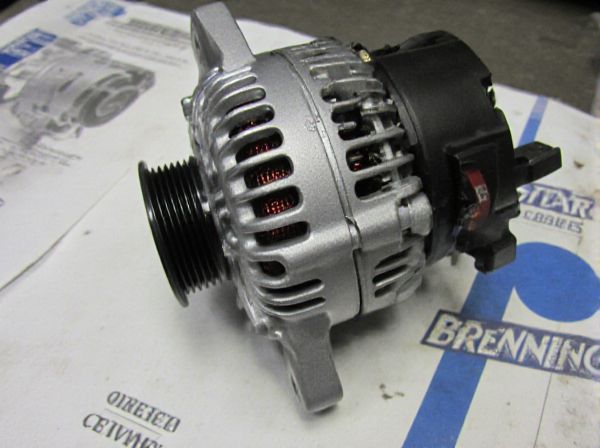
Photo illustration: Hairpin Winding vs Round Winding
Hairpin winding offers higher efficiency and better thermal management compared to round winding, making it ideal for high-power electric motors and EV applications. Round winding provides flexibility and simplicity in manufacturing, often used in traditional motor designs for smooth operation and ease of repair. Your choice depends on performance needs, with hairpin winding enhancing power density while round winding focuses on reliability and cost-effectiveness.
Table of Comparison
| Feature | Hairpin Winding | Round Winding |
|---|---|---|
| Construction | Flat rectangular copper bars, rigid structure | Flexible round copper wire, traditional coil shape |
| Efficiency | Higher electrical efficiency, lower resistance | Moderate efficiency, higher resistance losses |
| Thermal Management | Better heat dissipation, improved cooling | Limited heat dissipation, prone to hotspots |
| Durability | More robust, resistant to mechanical fatigue | Less durable, susceptible to winding damage |
| Manufacturing | Complex process, higher production cost | Simple winding process, lower cost |
| Performance | Optimized for high power and torque delivery | Standard performance, suitable for general use |
| Application | Modern alternators, electric vehicles | Conventional alternators, older car models |
Introduction to Hairpin Winding and Round Winding
Hairpin winding features rectangular copper conductors bent into U-shaped coils, enabling higher slot fill factors and improved thermal conductivity in electric motors. Round winding utilizes circular copper wires wound into coils, offering flexibility and ease of manufacturing for various motor designs. Both winding types influence motor performance, efficiency, and thermal management, making selection dependent on application requirements and production constraints.
Key Differences Between Hairpin and Round Winding
Hairpin winding features rectangular copper wires arranged in a parallel, flat configuration, enhancing slot fill factor and thermal dissipation compared to round winding, which uses circular copper wires coiled individually. The hairpin design allows for higher power density and improved mechanical stability, while round winding offers greater flexibility in winding pattern and simpler manufacturing for small-scale applications. Key differences include manufacturing complexity, electrical performance, and thermal management, with hairpin winding increasingly favored in high-efficiency electric motor production.
Advantages of Hairpin Winding
Hairpin winding offers higher power density and improved thermal management compared to round winding, enabling enhanced efficiency in electric motors. The design allows for better slot fill and reduced copper losses, which contribute to increased torque and efficiency. Its rectangular conductor shape simplifies automation in manufacturing, reducing production costs and ensuring consistent quality.
Benefits of Round Winding
Round winding offers superior thermal performance and higher electrical efficiency due to its uniform coil shape, which improves heat dissipation and reduces eddy current losses. The compact design of round winding enhances magnetic flux distribution, leading to improved motor torque and smoother operation. Manufacturing simplicity and better mechanical stability are additional benefits, resulting in longer motor lifespan and reduced maintenance costs.
Efficiency Comparison: Hairpin vs Round Winding
Hairpin winding offers higher efficiency due to reduced resistance and improved thermal performance compared to round winding, which typically experiences greater copper losses. The flat, rectangular conductors in hairpin winding provide better slot fill and enhanced heat dissipation, contributing to lower operating temperatures and increased power density. Round winding, while simpler to manufacture, generally exhibits higher electrical losses and less effective cooling, resulting in reduced overall motor efficiency.
Manufacturing Process Overview
Hairpin winding involves the use of pre-formed rectangular copper bars bent into U-shapes, which are then inserted into stator slots, allowing automated placement and improved slot fill factors. Round winding utilizes continuous round copper wires wound around stator teeth, traditionally requiring manual or semi-automated processes for coil formation and insertion. The hairpin winding process benefits from enhanced automation and mechanical stability, while round winding offers flexibility in complex coil geometries but often involves slower, more labor-intensive manufacturing steps.
Application Areas for Each Technology
Hairpin winding technology is predominantly used in high-performance electric vehicle motors and industrial automation due to its ability to support higher current densities and improved thermal management. Round winding is preferred in traditional automotive motors, household appliances, and general-purpose electric machines for its simpler manufacturing process and robustness in varied operational environments. Both technologies cater to different application requirements, optimizing efficiency and durability based on motor design and performance demands.
Cost Implications and Considerations
Hairpin winding typically involves higher initial manufacturing costs due to the complexity of bending and joining rectangular copper bars, but it offers improved thermal efficiency and reduced copper losses, which can lower operational expenses over time. Round winding uses simpler, more flexible round wires that are less expensive to produce and easier to repair, resulting in lower upfront costs but potentially higher copper usage and heat dissipation challenges. Cost considerations must balance initial investment against long-term efficiency gains, maintenance requirements, and the specific application's performance demands.
Performance and Reliability Factors
Hairpin winding offers superior thermal management and mechanical stability compared to round winding, resulting in enhanced performance under high current loads and extended operational lifespan. Round winding provides better fill factor and flexibility in coil design but may suffer from increased electrical losses and mechanical stress, impacting reliability. Choosing hairpin winding over round winding improves efficiency and durability in electric motor applications, particularly in demanding environments.
Future Trends in Winding Technologies
Hairpin winding and round winding technologies are evolving with the integration of advanced automation and precision manufacturing, driving higher efficiency and thermal management in electric motor production. The rise of electric vehicles accelerates demand for hairpin winding due to its superior current-carrying capacity and compact design, enabling enhanced motor performance and reduced energy loss. Innovations in insulation materials and laser welding techniques further optimize both winding methods, promising increased durability and scalability in future applications.
 caratoz.com
caratoz.com